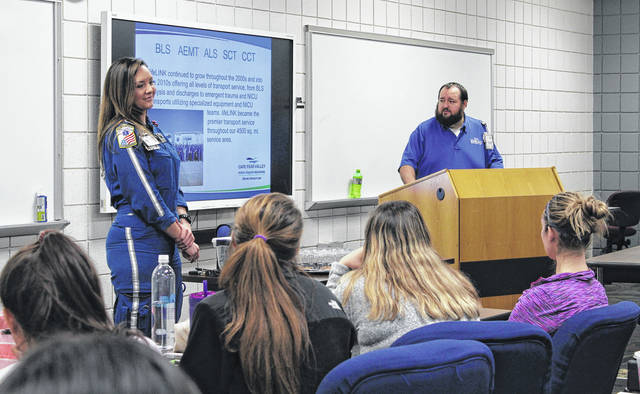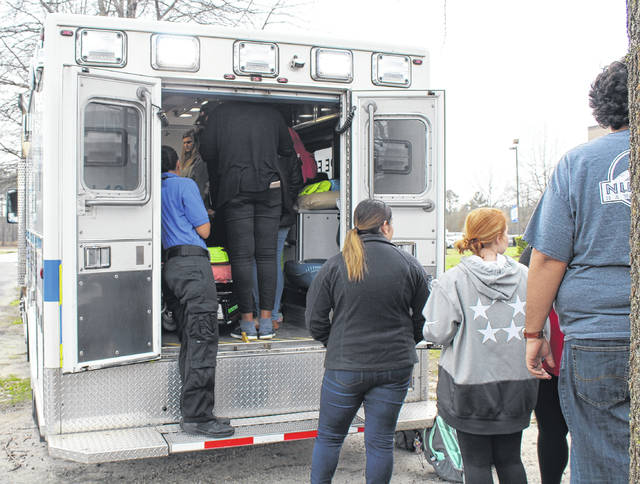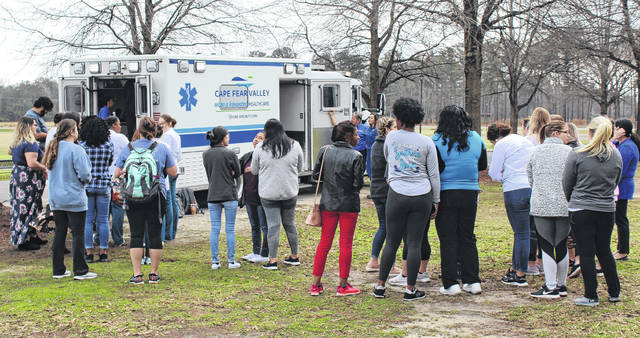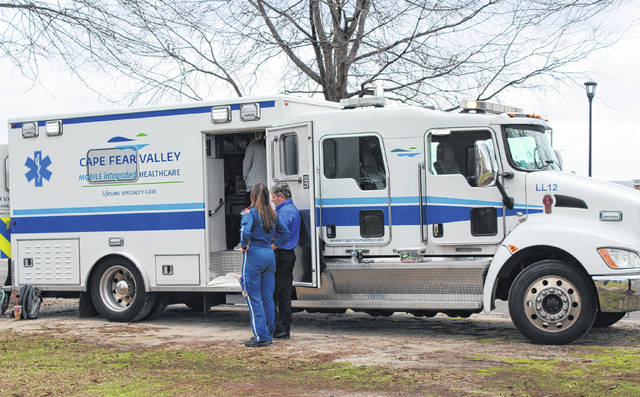Students at Sampson Community college received visitors from Lifelink Air to hear about what they do and what it takes to go into the life-saving business.
Registered nurse, Doug Fryar brought along some experts in the field. The group consisted of Fryar, Jennifer Baxley, RN and CFRN, Crystal Todd, EMTP and FPC and Rick Reichembach, EMT. They broke into teams of two and spoke in different classrooms about what their job consists of.
The topics up for discussion were career choices in critical care transport, flight nursing, flight paramedic and critical care EMS. Lifelink also explained the type of services they provide.
“Basically, we’re trying to educate them on the steps they have to take if they want to do this as a career,” Fryar commented. “You can’t just complete nursing school and come do the jobs we do.”
Education is only one component in getting the job. Another component involves a specific type of experience. Fryar hopes to educate the students on what they need to do to get this type of job.
Lifelink has also agreed to partner with Sampson Community College to work with Nursing and EMS students on specialized training. The group can come out when needed and provide simulations of experiences the students might cross in their real-life work. According to Fryar, this is a new partnership that he wanted to obtain.
Fryar graduated from Sampson, leading him to host Lifelink’s first event at the community college. An ulterior motive was to start recruitment for this line of work. He heads up the recruitment and public relations for Lifelink. The company is now looking for employees who meet the criteria.
The recruitment officer comes across nurses all the time who don’t know the steps of getting to the position he is in.
“If they start on the medical floor, that nursing experience really does not count toward the necessary training they need for the job,” Fryar added. “You have to have emergency room or ICU critical care experience because we usually deal with the sickest of the sick patients.”
The difference between being a nurse on the medical floor and being an EMT at Lifelink involves the treatment of the patients. EMTs have to take their patients out of a stable environment and transport them to another facility. Law states that the quality of care for any patient cannot decrease from one facility to the next. Therefore, the EMTs must maintain the quality of care given by the hospital.
In a hospital, a patient can have a doctor and a team of residents a moment away to jump in if anything happens that could endanger the patient’s life. During transport, all the patient has is whoever is riding in the back of the truck. Thus leading to one person having to be able to do the job of many with no extra hands unless the driver pulls over to assist.
“You have to be able to have the experience to do what needs to be done in that situation,” Fryar added.
Some hospitals don’t have the specialized treatment a patient may need to get better; hence the need for transport to a place that is better equipped to meet the needs of the patient.
According to Baxley, potential employees must be able to prioritize care, have critical thinking skills, be innovative, be able to do surgical airways, know how to manage ventilation and operate a balloon pump, be able to sedate a patient and many other skills.
“Our skill set is very broad compared to a normal nurse based in a hospital,” Baxley noted.
“Part of the job is to act as a doctor on the scene,” Fryar added.
The flight nurse explained to the class that Lifelink was started in 1994 when Cape Fear Valley needed to upgrade the company. Patients had to be transferred in from other hospitals to Cape Fear, developing a need for decent transportation for critical patients. A registered nurse, paramedic and an EMT made up what is now known as Lifelink Specialty care. The original crew consisted of six members and one ambulance that would get pages out by radio to respond to calls. The company received a second ambulance in the Spring of 1997. The as-needed company turned into a 24-hour unit.
Lifelink provides services such as dialysis, discharges, transports, trauma and NICU (newborn intensive care unit) transport.
They partner with Sampson, Harnett, Cumberland, Robeson, Scotland, Hoke and Bladen counties. Their helicopters are outsourced from Cape Fear with one stationed at Scotland and the other at Harnett. These counties are their primary locations but exceptions have been made. Fryar recently had to travel to Myrtle Beach and back in one day.
“We pride ourselves on mobile integrative care from ground to air all levels,” Baxley stated to the class. “After seven years of UNC air-care serving patients at Cape Fear Valley, we finally got our own helicopter.”
Now non-emergent patients can be transported by an ambulance and critical patients can be transported through helicopter.
Last month, the company had a call volume of 79 flights.
“When you see the bad wrecks on the interstate, we’re the ones getting called out and landing on the interstate to pick up the patient and take the critical patient to a trauma one facility,” Baxley explained.
The crew has different time limits set in place for the ground and air transports. They are aware that critical patients need to get seen quickly.
“Currently we’re very excited for the state of where we’re at with our company and Cape Fear Valley, more specifically as a Lifelink team member,” Baxley added. “We’ve seen so much growth and opportunity here. We’re increasing. We’re constantly hiring.”
Baxley notified the students that when they graduate they should check out Lifelink if they’re interested. Fryar explained that Cape Fear was a good place to gain experience.
“Get your experience and come check us out,” Baxley stated.
Ride-along packets were brought in for the students interested in really seeing what Lifelink members go through daily.
The group plans to send more teams out to schools to help the students train and understand what they need to do to get a job at Lifelink. The company hopes to initiate an internship/residency program to help students get their necessary experience within the next year. Fryar noted that experience is key and he wants to do what it takes to help educate others.




